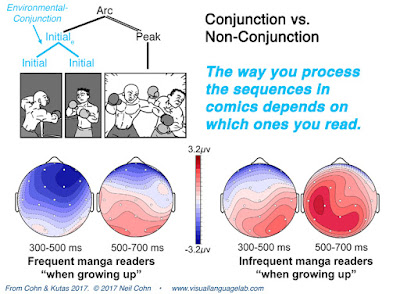2017: My publications in review
Last year I summarized all the papers I published in 2016, and I thought it worked out so well I might as well keep it going. This year wasn’t quite the flurry of books and papers as last year (due largely to setting up a new EEG lab and submitting multiple grants), but we had several significant papers come out balancing both brainwave studies and corpus analyses.
So, here are the papers that I published in 2017…
Drawing the Line Between Constituent Structure and Coherence Relations in Visual Narratives (pdf) – This project with my former assistant Patrick Bender looked at people’s intuitions for how to “segment” visual narratives into different subsections. Contrary to work on events and discourse, we found that breaks in categories of my model of narrative grammar were better predictors of segmentation than just changes in meaning between images (like spatial or character changes).
 When a hit sounds like a kiss (pdf) – This project with Mirella Manfredi and Marta Kutas examined how the brain processes words that replace panels, like Pow! or Hit! replacing a climactic event. We found that the context of the sequence modulated the semantic processing of the words, and that descriptive words (Hit!) generated brain responses consistent with lower probability words than onomatopoeia (Pow!).
When a hit sounds like a kiss (pdf) – This project with Mirella Manfredi and Marta Kutas examined how the brain processes words that replace panels, like Pow! or Hit! replacing a climactic event. We found that the context of the sequence modulated the semantic processing of the words, and that descriptive words (Hit!) generated brain responses consistent with lower probability words than onomatopoeia (Pow!).
What’s your neural function, narrative conjunction? (online article, pdf) – I consider this to be one of my coolest and most interesting studies to date. With Marta Kutas, I examined the brain response to a narrative pattern called Environmental-Conjunction. We found that it elicits two types of brain responses consistent with grammatical processing in language. Other work has shown that Environmental-Conjunction appears more in Japanese manga than Western comics, and indeed we found that readership of manga modulated this brain response. So: the brain uses grammatical processing for narrative patterns, and people familiar with this pattern process it in ways that are different from people who are less familiar with it. In other words, the way you process the sequences in comics depends on which ones you read.
 A picture is worth more words over time (pdf) – This project with co-authors Ryan Taylor and Kaitlin Pederson is the companion to last year’s paper by Kaitlin on how page layouts have changed in superhero comics over the past 80 years. Here, we look at how text-image interactions and storytelling methods have changed from the 1940s to 2010s in American superhero comics. Here’s also a link to Ryan presenting this work at Comic-Con International a few years ago.
A picture is worth more words over time (pdf) – This project with co-authors Ryan Taylor and Kaitlin Pederson is the companion to last year’s paper by Kaitlin on how page layouts have changed in superhero comics over the past 80 years. Here, we look at how text-image interactions and storytelling methods have changed from the 1940s to 2010s in American superhero comics. Here’s also a link to Ryan presenting this work at Comic-Con International a few years ago.
Path salience in motion events from verbal and visual languages (pdf) – In this corpus study we examined how paths are depicted in 35 different comics from 6 different countries around the world. We found that the patterns of paths differed along dimensions similar to what is found in distinctions of those authors’ spoken languages, hinting at possible connections between a visual language that one draws and the spoken language one speaks or writes.
Not so secret agents (pdf) – This paper with Marta Kutas looked at the brain processes of certain postures of characters in events. We found that preparatory postures (like reaching back to throw a ball or to punch) differed from those that did not hint at such subsequent events.
Not a bad collection, if I do say so myself. I’m already excited about the new work set to come out next year, so stay tuned. All these papers and more are available online here.
Comments